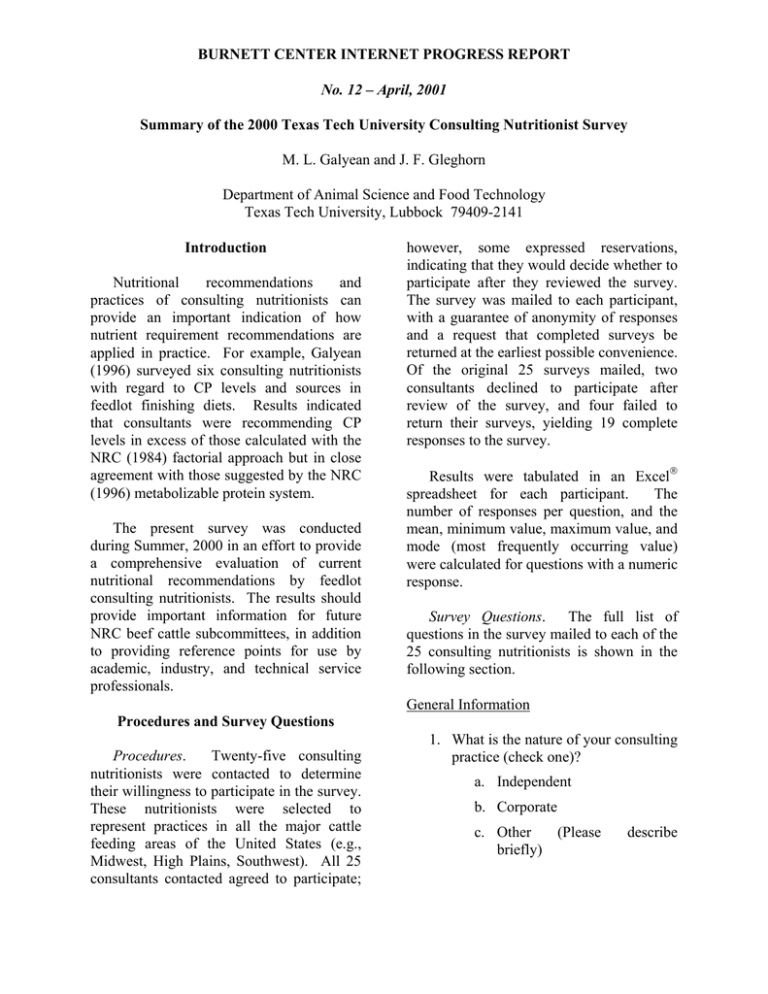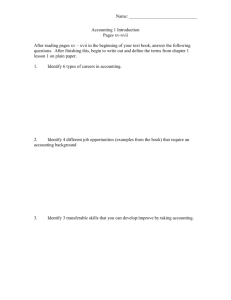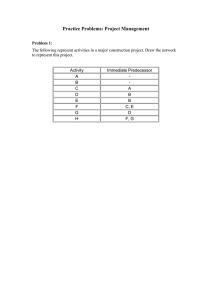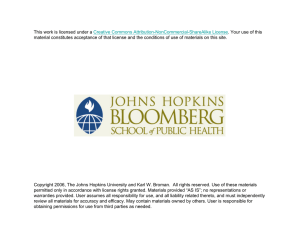BURNETT CENTER INTERNET PROGRESS REPORT No. 12 – April, 2001
advertisement

BURNETT CENTER INTERNET PROGRESS REPORT No. 12 – April, 2001 Summary of the 2000 Texas Tech University Consulting Nutritionist Survey M. L. Galyean and J. F. Gleghorn Department of Animal Science and Food Technology Texas Tech University, Lubbock 79409-2141 Introduction Nutritional recommendations and practices of consulting nutritionists can provide an important indication of how nutrient requirement recommendations are applied in practice. For example, Galyean (1996) surveyed six consulting nutritionists with regard to CP levels and sources in feedlot finishing diets. Results indicated that consultants were recommending CP levels in excess of those calculated with the NRC (1984) factorial approach but in close agreement with those suggested by the NRC (1996) metabolizable protein system. The present survey was conducted during Summer, 2000 in an effort to provide a comprehensive evaluation of current nutritional recommendations by feedlot consulting nutritionists. The results should provide important information for future NRC beef cattle subcommittees, in addition to providing reference points for use by academic, industry, and technical service professionals. however, some expressed reservations, indicating that they would decide whether to participate after they reviewed the survey. The survey was mailed to each participant, with a guarantee of anonymity of responses and a request that completed surveys be returned at the earliest possible convenience. Of the original 25 surveys mailed, two consultants declined to participate after review of the survey, and four failed to return their surveys, yielding 19 complete responses to the survey. Results were tabulated in an Excel spreadsheet for each participant. The number of responses per question, and the mean, minimum value, maximum value, and mode (most frequently occurring value) were calculated for questions with a numeric response. Survey Questions. The full list of questions in the survey mailed to each of the 25 consulting nutritionists is shown in the following section. General Information Procedures and Survey Questions Procedures. Twenty-five consulting nutritionists were contacted to determine their willingness to participate in the survey. These nutritionists were selected to represent practices in all the major cattle feeding areas of the United States (e.g., Midwest, High Plains, Southwest). All 25 consultants contacted agreed to participate; 1. What is the nature of your consulting practice (check one)? a. Independent b. Corporate c. Other briefly) (Please describe Roughage Sources and Level 2. Approximate number of cattle per year that your practice serves? 1. Primary roughage source used by your clients in finishing diets? 3. States in which your clients are located? General Commodity Finishing Diets Information Second most common roughage source used? for 2. Level of inclusion of roughage in finishing diets (% of DM)? Grains and Grain Processing – Please classify mixtures of grains or grain processing methods as a specific type of grain or grain processing method – e.g., primary grain = corn + wheat mixture, or primary grain processing = steam flaking + high moisture harvesting. Supplements and Micro Ingredients 1. Percentage of your clients who use the following in finishing diets? Liquid supplements Pelleted dry supplements 1. Primary grain used by your clients in finishing diets? Loose (meal) supplements Second most common grain used? dry 2. Percentage of your clients who use micro-ingredient machines? 2. Primary grain processing method used in finishing diets? Liquid Feeds Second most common processing method used? 3. Level of inclusion of grain in the finishing diet (% of DM)? 1. Percentage of your clients who use added non-fat liquids in finishing diets? 4. Bulk density and(or) starch availability recommended when steam-flaked grains are used? a. Primary non-fat liquid used in finishing diets? b. Recommended level of nonfat liquid in finishing diets (% of DM)? a. Corn b. Milo Grain Byproduct Use 2. Percentage of your clients who use added fat in finishing diets? 1. Percentage of your clients who use grain byproducts in finishing diets? a. Primary fat source used in finishing diets? Primary grain byproduct used in finishing diets? b. Recommended level of fat in finishing diets (% of DM)? 2. Level of inclusion of grain byproduct in finishing diets (% of DM)? Formulation Information for Finishing Diets 2 Information Resources for Nutritional Recommendations b. Primary source supplemental P if used? 3. Magnesium level recommended in finishing diets (% of DM)? 1. What is the primary source of information on nutrient requirements of beef cattle that you use in formulating nutritional recommendations? 4. Potassium level recommended in finishing diets (% of DM)? 5. Sulfur level recommended finishing diets (% of DM)? a. NRC (1976) c. NRC (1996) 7. Extent to which concentrations of major minerals in basal dietary ingredients are considered in formulation (check appropriate answer)? d. Other (Please specify) If you use the NRC (1996) publication for beef cattle, do you use Level 1, Level 2, or both? a. Basal mineral concentrations are given full value in formulation. Protein Level and Sources 3. Protein level recommended finishing diets (% of DM)? for 4. Urea level recommended finishing diets (% of DM)? for b. Basal minerals concentrations are given partial value in formulation. Please provide the partial value assumed for each major mineral. 5. Primary natural protein source used by your clients? Second most used natural protein source? Trace Mineral Levels and Sources 6. Do you formulate for degraded intake protein (DIP) and undegraded intake protein (UIP)? 1. Level of copper recommended in finishing diets (mg/kg of DM)? a. Primary source of copper used? Major Mineral Levels 1. Calcium level recommended finishing diets (% of DM)? in 6. Salt level recommended in finishing diets (% of DM)? b. NRC (1984) 2. of in b. Assumed value of copper in basal ingredients (% of total)? Primary source of supplemental calcium? 2. Level of zinc recommended in finishing diets (mg/kg of DM)? 2. Phosphorus level recommended in finishing diets (% of DM)? a. Primary source of zinc used? a. Is supplemental P added to finishing diets? 3 Vitamin Supplementation Practices b. Assumed value of zinc in basal ingredients (% of total)? 1. Vitamin A level recommended in finishing diets (specify IU/lb or IU/kg)? 3. Level of manganese recommended in finishing diets (mg/kg of DM)? 2. Vitamin E level recommended in finishing diets (specify IU/lb or IU/kg)? a. Primary source of manganese used? b. Assumed value of manganese in basal ingredients (% of total)? Special Considerations for Stressed (Newly Received) Cattle 4. Level of iron recommended in finishing diets (mg/kg of DM)? a. Primary source of iron used? 1. Recommended level of CP in the receiving diet (% of DM)? b. Assumed value of iron in basal ingredients (% of total)? 2. Recommended level of roughage in the receiving diet (% of DM)? 3. Preferred grain for the receiving diet? 5. Level of selenium recommended in finishing diets (mg/kg of DM)? 4. Preferred grain processing method for the receiving diet? a. Primary source of selenium used? 5. Is hay offered to cattle on arrival? If yes, for how long is hay fed? b. Assumed value of selenium in basal ingredients (% of total)? 6. Are grain byproducts used in the receiving diet, and if so, which byproducts? 6. Level of iodine recommended in finishing diets (mg/kg of DM)? 7. Recommended levels of major minerals for stressed cattle in complete diet: a. Primary source of iodine used? b. Assumed value of iodine in basal ingredients (% of total)? a. Calcium (% of DM)? b. Phosphorus (% of DM)? c. Magnesium (% of DM)? 7. Level of cobalt recommended in finishing diets (mg/kg of DM)? d. Potassium (% of DM)? e. Salt (% of DM)? a. Primary source of cobalt used? 8. Recommended levels of trace minerals for stressed cattle in the complete diet: b. Assumed value of cobalt in basal ingredients (% of total)? a. Copper (mg/kg of DM)? 4 or anticipated regulations? If so, which nutrient recommendations have been altered or will be altered? Recommended ratio of inorganic:organic sources? b. Zinc (mg/kg of DM)? 2. Are there any other nutrients besides those listed above, particularly minerals or vitamins, which you supplement in finishing diets? Recommended ratio of inorganic:organic sources? c. Manganese (mg/kg of DM)? 3. Are there any other nutrients besides those listed above that you think might be promising supplements in finishing diets but for which additional research is needed before you would recommend their use? Recommended ratio of inorganic:organic sources? d. Iron (mg/kg of DM)? Recommended ratio of inorganic:organic sources? Results and Discussion Summarized responses to most of the survey questions are shown in Table 1. Some questions yielded sufficiently varied responses (e.g., protein and mineral sources used in finishing diets) that we chose not to include a summary of them in Table 1. e. Selenium (mg/kg of DM)? Recommended ratio of inorganic:organic sources? f. Iodine (mg/kg of DM)? Recommended ratio of inorganic:organic sources? Corn was clearly the principal grain used by the feedlots serviced by these nutritionists, with steam flaking being the most important processing method. Alfalfa was the most common roughage source, followed by corn silage. Use of other roughage sources seemed to be very limited. For the most part, the average values for nutrient recommendations tended to agree with recommendations of NRC (1984, 1996). Average CP level in the finishing diet was very similar to that reported by Galyean (1996), and most major and trace mineral recommendations fell within a range of from one to two times the NRC (1984, 1996) recommendations. The average vitamin A level was approximately twice the NRC (1984, 1996) recommendation, whereas vitamin E fortification practices seemed slightly lower than NRC (1984, 1996) recommendations. Nutrient g. Cobalt (mg/kg of DM)? Recommended ratio of inorganic:organic sources? 9. Recommended vitamin A level in receiving diets (specify IU/lb or IU/kg)? 10. Recommended vitamin E level in receiving diets (specify IU/lb or IU/kg)? Additional Questions 1. Have you altered or plan to alter recommendations on nutrient concentrations in finishing diets as a result of environmental regulations 5 recommendations for diets of newly received cattle generally followed NRC (1996) guidelines. Summary and Conclusions Nineteen consulting nutritionists representing all the major cattle feeding areas of the United States responded to the Texas Tech University Consulting Nutritionist Survey – 2000. Summary data from this survey should provide valuable information for subsequent revisions of the NRC publication on beef cattle nutrient requirements. In addition, these results provide a useful benchmark of industry nutrition practices for evaluation and use by academic and industry professionals. Literature Cited Galyean, M. L. 1996. Protein levels in beef cattle finishing diets: Industry application, university research, and systems results. J. Anim. Sci. 74:2860. NRC. 1984. Nutrient Requirements of Beef Cattle (6th ed.). National Academy Press, Washington, DC. NRC. 1996. Nutrient Requirements of Beef Cattle (7th ed.). National Academy Press, Washington, DC. 6 Table 1. Consulting Nutritionist Survey - 2000 - Overall Summarya Question Cattle serviced per year by practice Primary grain used Secondary grain used Primary grain processing method Grain in finishing diet Corn bulk density, lb/bu Corn starch availability Milo bulk density, lb/bu Milo starch availability Primary roughage source used Secondary roughage source used Roughage level in finishing diet Client use of liquid supplement Client use of pelleted supplement Client use of loose meal supplement Client use of micro-machines Client use of non-fat liquid Non-fat liquid level in finishing diet Client use of fat Fat level in finishing diet Information source Protein level in finishing diets Urea level (x 2.87 for NPN) Formulate with DIP and UIP Calcium level in finishing diet Phosphorus level in finishing diet Magnesium level in finishing diet Potassium level in finishing diet Sulfur level in finishing diet Mean Count Min Max Mode 735,278 17 = corn; 2 = corn & milo 6 = milo; 5 = wheat; 2 = barley; 3 = milo & wheat; 3 = not applicable 15 = steam flaked; 3 = dry rolled 78.00% 26.97 57.40 25.89 63.25 13 = alfalfa; 4 = corn silage; 1 = cottonseed hulls; 1 = sudan hay 10=corn silage; 4 = alfalfa; 2 = cottonseed hulls; 3 = other 8.89% 58.37% 40.71% 13.00% 41.63% 71.79% 4.13% 76.00% 3.68% 8 = 1984; 6 = 1996; 4 = both 1984 & 1996; 1 = both 1976 & 1996 13.31% 1.05% 14 = No; 5 = Yes 0.70% 0.31% 0.21% 0.74% 0.19% 18 19 19 18 18 16 10 14 6 19 19 19 19 17 18 19 19 18 19 19 19 19 13 19 18 18 18 19 13 20,000 66.00% 22 50 22 57.5 4.50% 0.00% 0.00% 0.00% 0.00% 10.00% 1.75% 0.00% 2.50% 12.50% 0.78% 0.60% 0.25% 0.15% 0.60% 0.10% 2,500,000 87.00% 29 65 29 70 13.50% 100.00% 100.00% 100.00% 100.00% 100.00% 7.50% 100.00% 6.50% 14.00% 1.35% 0.90% 0.35% 0.30% 1.00% 0.34% 600,000 80.00% 26 57.5 27 9.00% 80.00% 20.00% 0.00% 0.00% 100.00% 4.00% 100.00% 2.50% 13.50% 1.1% 0.70% 0.30% 0.20% 0.70% 0.20% 7 Table 1 (Cont.). Consulting Nutritionist Survey - 2000 - Overall Summarya Question Salt level in finishing diet Copper level in finishing diet, mg/kg Value of basal ingredient copper Zinc level in finishing diet, mg/kg Value of basal ingredient zinc Manganese level in finishing diet, mg/kg Value of basal ingredient manganese Iron level in finishing diet, mg/kg Value of basal ingredient iron Selenium level in finishing diet, mg/kg Value of basal ingredient selenium Iodine level in finishing diet, mg/kg Value of basal ingredient iodine Cobalt level in finishing diet, mg/kg Value of basal ingredient cobalt Vitamin A level in finishing diet, IU/lb Vitamin E level in finishing diet, IU/lb Protein level in receiving diets Roughage level in receiving diets Calcium level in receiving diet Phosphorus level in receiving diet Magnesium level in receiving diet Potassium level in receiving diet Salt level in receiving diet Copper level in receiving diet, mg/kg Organic copper use Zinc level in receiving diet, mg/kg Organic zinc use Manganese level in receiving diet, mg/kg Organic manganese use Mean Count Min Max Mode 0.35% 14.75 65.20% 74.03 59.94% 38.28 63.13% 55.90 84.55% 0.21 46.33% 0.75 29.67% 0.24 41.25% 2,070.2 3.64 14.44% 33.67% 0.78% 0.35% 0.25% 1.15% 0.42% 20.42 17.50% 94.06 23.85% 49.33 7.73% 17 19 16 19 17 19 17 16 12 19 16 16 16 18 17 13 12 17 18 19 19 18 19 19 18 12 18 13 18 11 0.25% 6 0.00% 15 0.00% 12 0.00% 0 0.00% 0.06 0.00% 0.1 0.00% 0.06 0.00% 1,500 0 13.75% 13.50% 0.55% 0.25% 0.18% 0.70% 0.25% 11 0.00% 33 0.00% 22 0.00% 0.50% 20 100.00% 150 100.00% 80 100.00% 150 100.00% 0.3 100.00% 1.5 100.00% 0.59 100.00% 3,300 10 16.00% 48.00% 1.00% 0.40% 0.50% 1.70% 0.60% 40 50.00% 150 75.00% 120 30.00% 0.25% 20 100.00% 50 100.00% 40 100.00% 50 100.00% 0.3 0.00% 0.5 0.00% 0.1 0.00% 2,000 0 14.00% 40.00% 0.75% 0.35% 0.25% 1.10% 0.50% 20 0.00% 150 0.00% 50 0.00% 8 Table 1 (Cont.). Consulting Nutritionist Survey - 2000 - Overall Summarya Question Mean Count Min Max Mode Iron level in receiving diet, mg/kg Organic iron use Selenium level in receiving diet, mg/kg Organic selenium use Iodine level in receiving diet, mg/kg Organic iodine use Cobalt level in receiving diet, mg/kg Organic cobalt use Vitamin A level in receiving diet, IU/lb Vitamin E level in receiving diet, IU/lb 66.3 0.00% 0.25 0.00% 0.92 47.5% 0.33 3.89% 3,660.4 19.2 16 8 17 9 17 8 18 9 12 13 0 0.00% 0.1 0.00% 0.1 0.00% 0.07 0.00% 1,600 0 150 0.00% 0.3 0.00% 2 100.00% 1 30.00% 7,000 60 50 0.00% 0.3 0.00% 1 0.00% 0.5 0.00% 3,000 15 a 19 respondents total; Count indicates respondents per question. 9



